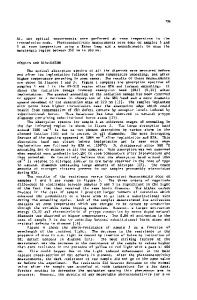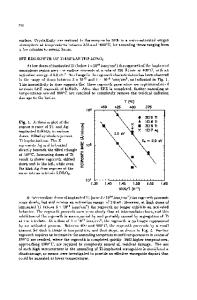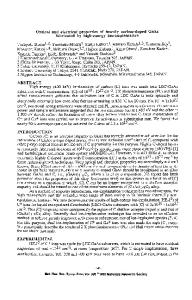Optical properties of the black diamond produced by ion implantation
- PDF / 233,338 Bytes
- 5 Pages / 584.957 x 782.986 pts Page_size
- 33 Downloads / 484 Views
Young-Chool Kim Hanmi Gemological Institute Laboratory, Bongik-dong, Jongno-gu, Seoul 110-390, Korea (Received 8 February 2011; accepted 1 June 2011)
The optical properties of N-ion-implanted diamond are evaluated. The color of implanted layer became glossy black with metallic luster, which was further enhanced after postimplantation annealing at 600 °C for 2 h in vacuum or inert gas atmosphere. Raman spectroscopy revealed that the crystalline diamond became completely disordered after irradiation, but surprisingly the crystalline nature was restored to a mixture of well-defined diamond and diamond-like carbon after annealing. When it was annealed in air at the same temperature, however, the black color disappeared, indicating a removal of the disordered or graphitized layer by oxidation. X-ray photoelectron spectroscopy and Raman analyses indicate that the black color of as-implanted diamond is associated mainly with the disordered carbon and modified band structure. Fourier transform infrared (FTIR) analysis shows that the implanted nitrogen atoms are in N–N and symmetrical 4N-vacancy bonding states, which are commonly found in the natural diamonds with yellow and brown tint.
I. INTRODUCTION
Perfect crystalline diamond, a dense polymorph of carbon, has an indirect band gap of 5.5 eV and is transparent in the visible part of the light spectrum. However, most gem diamonds contain appm level of defects such as vacancies, interstitials, and substitutional impurity atoms. The presence of these defects can affect the associated energy levels within the band gap, resulting in changes in optical properties. The color change of a diamond arises because of the modification of the absorption and/or photoluminescence characteristics, which is dependent on the type and the concentration of the defects, including impurity atoms and irradiation-induced defects. Black diamonds are relatively rare in nature, but for their beauty, they have been introduced as gemstone since late 1990s, both in natural and in artificial forms. A colored diamond has been produced by neutron irradiation in a nuclear reactor, and such diamond has shown deep blue to green color. Recently, a black diamond has been produced by high-temperature treatment of poor quality polycrystalline diamonds.1 In this treatment, the color of the diamond changed to black on the surface because of graphitization, often showing crack-like defects through the surface. It was reported that an introduction of nitrogen atoms into substitutional lattice sites of diamond produced a defect energy level at ;1.7 eV below the conduction band,2 which
resulted in yellow-brown color because of the characteristic absorption at the defects, so often called color centers. This article reports that from a commercial grade single-crystalline diamond, a black diamond is produced by 70 keV N-ion implantation. X-ray photoelectron spectroscopy (XPS), Fourier transform infrared (FTIR), and Raman analyses indicate that the effect of N-ion implantation followed by an annealing is similar to that
Data Loading...











